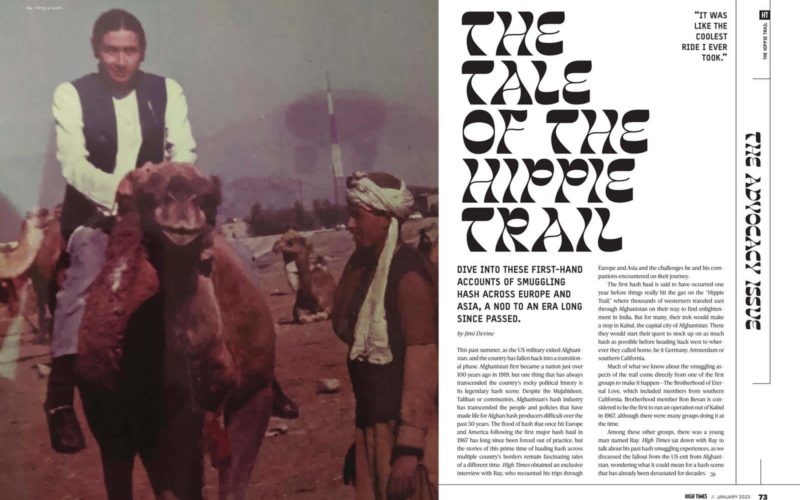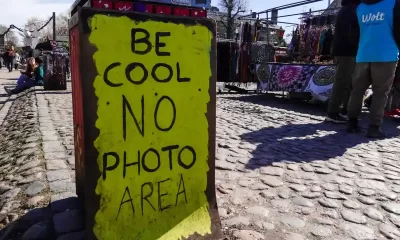Crime
The Tale of the Hippie Trail

Dive into these first-hand accounts of smuggling hash across Europe and Asia, a nod to an era long since passed.
This past summer, as the US military exited Afghanistan, and the country has fallen back into a transitional phase. Afghanistan first became a nation just over 100 years ago in 1919, but one thing that has always transcended the country’s rocky political history is its legendary hash scene. Despite the Mujahideen, Taliban or communists, Afghanistan’s hash industry has transcended the people and policies that have made life for Afghan hash producers difficult over the past 50 years. The flood of hash that once hit Europe and America following the first major hash haul in 1967 has long since been forced out of practice, but the stories of this prime time of hauling hash across multiple country’s borders remain fascinating tales of a different time. High Times obtained an exclusive interview with Ray, who recounted his trips through Europe and Asia and the challenges he and his companions encountered on their journey.
The first hash haul is said to have occurred one year before things really hit the gas on the “Hippie Trail,” where thousands of westerners traveled east through Afghanistan on their way to find enlightenment in India. But for many, their trek would make a stop in Kabul, the capital city of Afghanistan. There they would start their quest to stock up on as much hash as possible before heading back west to wherever they called home; be it Germany, Amsterdam or southern California.
Much of what we know about the smuggling aspects of the trail come directly from one of the first groups to make it happen—The Brotherhood of Eternal Love, which included members from southern California. Brotherhood member Ron Bevan is considered to be the first to run an operation out of Kabul in 1967, although there were many groups doing it at the time.
Among these other groups, there was a young man named Ray. High Times sat down with Ray to talk about his past hash smuggling experiences, as we discussed the fallout from the US exit from Afghanistan, wondering what it could mean for a hash scene that has already been devastated for decades.
Hop In—We’re Going Smuggling
The days before Ray’s first trip to Afghanistan were filled with proper hippie business. “We went to southern Oregon in the late ’60s and for whatever reason out of pure synchronicity a bunch of us from northern California and southern California all ended up in this one house in southern Oregon,” Ray told High Times.
The group decided to take things to the next level and looked to start a commune. They spent some time hunting for a property, but after some hiccups with the search, they regrouped in California in 1968. A lot of the people that originally tossed that idea around remain friends to this day after originally finding each other all those years ago.
Part of that group included some friends who had already been smuggling hash from Afghanistan a year or two before that, and they had just brought back a load. In those days, Ray and his friends were staying in the High Sierras—the perfect place to unload some hash.
Most people associate the “Hippie Trail” with the image of a classic Volkswagen bus and a Hanomag Camper that rolled up to their spot in the same hills that was also very popular with other hash smugglers, such as Darrell. “He came, we unloaded it there, and it took a while. And after he got what he thought was the load amount he goes, ‘Okay, you guys can have the rest.’ And so we picked away at it because it was in the framework,” Ray said, “We had to use all kinds of tools we implement to dig it all out but I think eventually we got like another 10 pounds.”
This would be the first time Ray mentioned the man that he eventually partnered with to make the travel east. “So you know we are quite thrilled to make a connection with him. This is Long Beach, brother, I can give you his name because he’s no longer with us. Well, he had many names, but we knew him as Darrell,” Ray noted with a laugh.
Before connecting with Ray, Darrell had already made two or three trips. He was always a driver, and for good reason. In this critical role, he was the main person who drove from Holland to Kabul and back, through every border. He didn’t even need a map when he was on his runs.
Eventually Darrell shared his next plan with Ray: “Here’s what I want to do next time because I’m gonna have another Honomag, but also I’m going to buy a really nice motorhome,” Darrell told Ray at the time.
The motorhome was called a Revcon. It was the top-of-the-line in 1968 when it was designed. It had an aerodynamic aluminum body, and the 26 rails that ran the length of its frame were a hash smuggler’s dream.
“Very cool, very modern, front wheel drive. And he goes ‘I’m gonna buy this and we’re gonna, this is the vehicle we’re gonna make special rails that go inside the rails and we’ll have little hooks to pull it out,”’ Ray said of Darrell’s original plan.
Ray and Darrell had some friends that were engineers who helped them with building the rails. Eventually they would drive the Revcon across the country from California to New York, shipping it on to Rotterdam, Netherlands.
Darrell asked Ray to tag along for the full run to Afghanistan. “I go, ‘Sure, I’ll go slide and sit shotgun,”’ Ray replied. “It was like the coolest ride I ever took. But we were vegetarian at the time, so we were doing a lot of soups, avocados and carrot juice. We had it all decked out with the Norwalk Press, which is a real good juicing machine. We totally kept our eating habits intact.” Their eating habits would eventually earn them the nickname “The Carrot Juice Boys.”
The group prepped for their journey from Rotterdam after picking up the Revcon. They would make their way through Germany and Austria, then travel through Yugoslavia, Bulgaria, Turkey and Iran before finally reaching the Afghan Border.
That first trip would end up taking a few months, after Ray and Darrell got caught up in eastern Turkey. The Revcon’s front wheel drive engine featured torsion bars in the front, which didn’t pair well with the traffic or potholes they encountered on their journey. They lost control of the Revcon for a second, but were able to come to a stop in the center median. “Eastern Turkey is definitely the sticks, very isolated and very desolate,” Ray said of the breakdown.
When you break down out there, it’s common to surround your vehicle with rocks. They did so before hitchhiking to the closest town. They brought mechanics back to the Revcon, knowing they wouldn’t be able to replace the bar, but could rig something to get the Revcon back to civilization.
They hobbled into Tehran, Iran and messaged home for the part they needed. It wasn’t a fast process. “So we were in Tehran for about a good month, repairing the vehicle, but everything got straightened down,” Ray said, “So we rolled into Afghanistan, probably in late summer of 1970.”
Of Science and Borders
The mission was to obtain a couple hundred pounds of hash and five gallons of hash oil. While other groups had brought hash loads back for about three years before this trip, to the best of The Carrot Juice Boys’ knowledge, they were the first people ever to bring a flash evaporator to Afghanistan. Much of the Revcon was loaded with Everclear for their grand chemistry project.
If the idea of driving across the middle east with a chemistry set seemed weird, the opulence of the Revcon stole everyone’s attention at each border crossing, simplifying getting its contents across various borders in both directions. “I mean, they’ve seen the ‘Hippie Trail’ in the VW Vans, the Honomags, but they’ve never seen anything of this magnitude in this amazing really cool motorhome,” Ray noted on the border crossings. “And of course once we got into Persia we decked it out with Persian carpets and runners and it was looking really cool.”
They were very much playing the part of rich Californians, but they would still be pulled from the line at every border. “The head custom guy would come out and just wanted to go inside and look at it and say ‘oh very nice,”’ Ray said, “It’s just amazing.”
One time, a border agent pulled out their chemistry set and pulled out a beaker. He asked Darrell and the pair what it was. “Glass,” they replied. The border guard looked at it again, nodded in agreement with their take, and put it back in the box.
Iran had some of the toughest border restrictions, but once you entered the country, the group found that it was amongst the most welcoming as they attempted to Westernize before the Shah fell in 1979. Ray emphasized that it was one of the nicest places he’s ever been to, as they spent the month waiting for car parts. “They just want to make sure you’re [not] smuggling weapons or anything, doing nefarious stuff, but all the people there were so nice,” Ray noted of Tehran. “They just were so hospitable and helped us [with] whatever. If we’d go looking for the embassy, [residents] would take us in their car, take us to their home, feed us and then take us to the embassy.”
But with a repaired Revcon, things got a bit rougher as they approached the Afghanistan border. Every hotel featured signs that warned a prison sentence of 10 years in prison for a gram of hash, and life in prison for a kilo. “They try and put the fear in you, but we got some good hash in Turkey,” Ray said with a laugh.
After getting into Afghanistan, the group headed straight for Kabul. They stayed in a fancy neighborhood fitting of rich Californians. From there, they would head to The Solan Hotel, a hotspot for hash enthusiasts and general tourists heading in both directions on the trail.
One of Ray’s favorite things about The Solan Hotel was a space attached to the courtyard where you could park your van and camp near a little park attached to the hotel. There was always an ongoing rotation of Europeans and a few Americans, and it was always a good time.
The locals did their best to keep the hippies and smugglers happy, too. “Afghanis just loved us because we had money and we were very careful about religion,” Ray said. “We were very aware of how they are and how not to trespass or do anything [that] goes counter to them. There’s just some things so you don’t mess with. You don’t eat during the day during Ramadan and walk around chewing food.”
But Ray argued that besides that kind of thing, the religion of Islam was based in hospitality. Over the course of three trips that, in total, took about a year to complete, Ray picked up some language skills. One of the things he noticed immediately was how caring and personal everything was. He noted that a lot of the conversation focused on how the other person was feeling.
Back in their Kabul neighborhood, they rented out a two-story mansion and set up the hash lab. They would do a lot of the extraction work offsite and then bring the crude material back to the flash evaporator in the bathroom to get all the alcohol out. It would take them a couple of months to get the five gallons of hash oil they were shooting for.
Unloading the Goods
High Times asked Ray how much hash they needed to make the five gallons. Ray estimated that about 200 kilos were concentrated into the oil. He also noted the unpressed hash made for much better oil, then they hid the rest to stuff in the specialized frames of the Revcon. “The rest we had pressed up and put into the containers, the square tubes, it actually ended up making the hash look like a Hershey bar. We sold most of that in Amsterdam and I’m sure to this day, there are a lot of people there who call it ‘screw hole hash,’” Ray said.
The hash received this name when they put five to seven of the bars together and put a screw through the stack, just to tighten it up before they tossed it down the tube designed to fit into the Revcon’s internal storage system. “It was a precise measurement that we had all the patties pressed,” Ray noted on the precision used to fill each tube with as much product as possible.
As for the oil, that came out pretty great, too. The flash evaporator kept the oil at a reasonable temperature as it sweat off the Everclear used in production. “I mean, it was a black oil. But because of the flash evaporator we didn’t have to heat it in a high temperature, it was in a vacuum, so you got the real essence of really, really good hash,” Ray said. “I don’t know if you’ve had really, really good hash but it’s very floral and very sweet.”
Just like today, in order to make the best oil possible, they had to get their hands on the best material possible. Ray described the process that took them around the country from their upscale Kabul hash lab and base camp. The first connection they ever made was in Kandahar, Afghanistan.
“We used to go to Kandahar, but that was a tough place to be,” Ray noted on the trip. “Kandahar was like going back 1,000 years. I was like ‘Oh my God. That was an ancient town.’ And you couldn’t help but get dysentery just hanging out there for any amount of time. But Kabul was more modern.” In addition to the more modern vibe in Kabul, you could basically get whatever you needed. And in reality, it wasn’t that competitive with other smugglers in town because there was just so much hash to go around.
When it was time to return, the Revcon would leave Afghanistan without Ray. They hired a German woman to play the role of a fancy lady with a fancy motorhome. “We paid her like $10,000 or something. And she was great! She had like a fur coat. I mean, she’d look the part of being wealthy,” Ray said. She was the perfect accessory for a driver who had already completed this trip five times before. The key was the balance of looking like a regular person. Not being an asshole, but also not being too nice, in the hopes of getting waved through borders smoothly.
Ray and Darrell made it to Holland with no problems. The Revcon worked like a charm before being unloaded on a small farm outside Amsterdam. Most of the load would be sold locally.
“But here’s a luggage story for you,” Ray laughed. While the hash moved in Europe, they decided to bring a bunch of the oil back to America. At the time, Ray estimated that the oil was selling for about $10 a milliliter, so a whole liter was worth roughly $10,000 bucks. “We went to a liquor store in Amsterdam and bought Kahlua. Then we’d melt the little seal and stretch it and pull it over the bottle, undo the cap and pour out all the Kahlua and then poured in the hash oil. Then we heated the seal back up and you know back the cap and so it looked sealed, and we’d take two bottles,” Ray said. “So, we go to the airport and we’d go to the duty free and buy another bottle of Kahlua and we traded out the bottle we bought at duty-free. So, we just carried it right across check-in.”
Ray emphasized not to forget the exchange rate. That $10,000 bottle in 1970 would be worth over $70,000 today. He can’t recall how many bottles made it back, the whole five gallons would be worth $1.2 million today.
Adapting the Experience
On Ray’s two trips to Afghanistan, he already had the lay of the land. He flew into Kabul and would buy the hash ahead of time to limit the time spent in the country compared to the marathon road trip and hash oil production of his inaugural adventure.
Ray’s first trip lasted so long he actually overstayed his visa. When he returned for the second run the customs people at the airport noticed it on his passport and gave him a shorter amount of time. After learning his lesson, he got a new passport for the third run. It did the trick, and it was clear sailing at customs. “So, I’d go ahead of time and get there and order up and make sure everything’s ready,” Ray said, “So when the vehicle came through it wasn’t just there, it was like it was going across. It wasn’t there longer than a week or two, which is about the average tourist time somebody might spend there.”
The later runs wouldn’t feature the Revcon. The team moved on to four-wheel drive Suburbans with special compartments in the gas tank that could hold over 100 pounds of gas. The only problem with it was you had to stop a lot more to fuel up, but the trucks did a lot better on the roads than a motorhome.
“But it was pretty safe because to get to it you’d have to take out the whole gas tank and cut into it,” Ray said, “And that was the last time that we did it. We actually hired a professional race driver, who was a dear friend, and he did a good job.”
The gang had a mission of wider psychedelic enlightenment between trips. As they made the runs through the early 1970s, a lot of the resources went into furthering that mission. The freedom Ray and his peers were in search of came with the smuggling and they wanted to make sure to pay it forward. What would start as personal projects for the group would eventually end up in the hands of nonprofits down the line in the form of an unfinished boat. “So the majority of the money that we ever made went on that boat, eventually when the Russians started coming in and put in the puppet government and everything we said, ‘okay, that’s done. We’re not going back there again,”’ Ray said.
Expanding Lore of the First Smuggler
Three years prior to Ray’s first run, Ronnie Bevan of the Brotherhood of Eternal Love would make the first major smuggling run out of Afghanistan. He released the first autobiography of a hash smuggler entitled Brotherhood Hashish: The Story of Ronnie Bevan in 2018.
Many people speak of the “Hippie Trail” as intertwined tales of the many tourists that passed through and a handful of preeminent smugglers like him. High Times asked Bevan to weigh in on that idea. “One thing was there was more than just the two,” Bevan quickly rebutted. “You could get on a bus in London and end up in Kathmandu and there are photos of those people going in 1967 or 1968. The girls have bouffant hairdos and they’re in tight skirts. And then you see him a year later in Kathmandu, and we’re in the hippie clothes and their hair is all down.”
Bevan found that was really the basic motivation of the of the European travelers. Thousands of Europeans made that trip, but very few Americans did, because of the overseas aspect. “We didn’t have the buses. There just weren’t that many. I know, all of the guys that were in Afghanistan smuggling because I was there through several years, and there just weren’t that many,” Bevan said.
Bevan explained that a lot of people in London, or wherever they went from, by the time they got to Nepal all of a sudden they were into the metaphysical side of everything and taking psychedelics. But not everyone. Some people were there for the opposite of self-help. “There also was another large group of people that just did drugs,” Bevan explained, “You could buy heroin, cocaine, you could buy either from the pharmacy in Afghanistan. And consequently, we saw a lot of druggie type people just hanging out. So that’s just another dimension to what you’re talking about.”
Technically, many date the “Hippie Trail” to beginning in 1968, one year after Bevan’s first run. Bevan went on to explain how those increased crowds impacted business. “In the early days nobody got busted for anything, it wasn’t until 1971 that somebody busted [in] one of the vans,” Bevan said.
By 1973, Bevan and his friends had a warrant poster, and he was on the run. That same year Afghanistan’s King Zahir Shah made hash illegal following a $47 million dollar payment from the US government. “Our people had to move into Pakistan to do their work, and it was pretty much destroyed after that. And then it faltered and then a lot of people got busted and especially in those Volkswagens. I think about eight of them, and from that point on, none of them made it they got every one of them but when the Russians came [in] 1979 it was over for sure. That it’s, been over since then.”
A recent article in the South China Morning Post spoke with a cannabis farmer and hash producer outside of Kandahar named Ghulam Ali. Ali noted he hasn’t had any problems since the most recent transition of power, despite concerns that the Taliban would crack down a lot more than the coalition-backed government that fell last summer. “We don’t hear a lot over there. But I think the Taliban is pretty much leaving everything alone,” Bevan replied after reading Ali’s story. “I think what they’re doing is they’re trying to get in there economically.”
It’s also important to remember that hash and Afghanistan have a much longer history than the Taliban does with the nation. “And I think the Taliban probably see that and realize that the people are going to be much happier and much easier to deal with if they let them have their culture,” Bevan argued.
Source: https://hightimes.com/culture/the-tale-of-the-hippie-trail/
Business
Pittsburgh Advocates Unite To Legalize Adult-Use Cannabis in Pennsylvania

Pittsburgh NORML is working to push forward legislation to allow cannabis for adults in Pennsylvania.
In Pennsylvania’s second-largest city, advocates are busy working to legalize adult-use cannabis.
Last month, two lawmakers introduced Senate Bill 846 to legalize adult-use cannabis in Pennsylvania. The bill currently waits for review from the Senate Law and Justice Committee for further deliberation. Next Pittsburgh reports that advocates at a local Pittsburgh branch of NORML are gearing up for legalization efforts in the state.
“This is a much bigger issue than just cannabis—it’s about giving people the right to be able to find health and wellness in the way that they want to and to not have to feel like the government will tell them how they’re allowed to heal,” says Gina Vensel, a cannabis educator and advocate in the area. Vensel is also on the executive committee of Pittsburgh NORML, the Pittsburgh branch of the National Organization for the Reform of Marijuana Laws (NORML).
SB 846 is a bipartisan effort and was spearheaded by Sens. Daniel Laughlin and Sharif Street. The bill would establish a Cannabis Regulatory Control Board, and allow adults 21 and over to purchase cannabis from retail locations. It would additionally allow medical cannabis cardholders to grow cannabis at home. Lastly it would expunge nonviolent cannabis-related convictions.
“Legalized adult use of marijuana is supported by an overwhelming majority of Pennsylvanians and this legislation accomplishes that while also ensuring safety and social equity,” Laughlin said in a statement. “With neighboring states New Jersey and New York implementing adult use, we have a duty to Pennsylvania taxpayers to legalize adult use marijuana to avoid losing out on hundreds of millions of dollars of new tax revenue and thousands of new jobs.”
Problems Remain in Pittsburgh
High Times reported in 2018 that Solevo Wellness was the city’s first medical dispensary, and is the fourth operating medical cannabis dispensary in the entire state of Pennsylvania. The process of establishing, licensing, and opening Solevo Wellness took about 18 months. The company credits much of their success in obtaining the proper permits to their hired industry consultant, Sara Gullickson.
Pittsburgh, located in Allegheny County, decriminalized cannabis in 2015. Part of the policy shift involved giving law enforcement a choice between arresting people for suspected cannabis offenses or simply giving them a citation. Further downstream the criminal legal system, prosecutors in Pennsylvania’s major cities enacted “decline to prosecute” policies for minor cannabis cases that went to trial.
Despite decriminalization locally, arrests for cannabis increased since Pittsburgh enacted decriminalization policies. Many officers at police departments are having a hard time letting go of the old policy, continuing to arrest rather than ticket suspected offenders.
Analyzing all the criminal dockets filed in Allegheny County from 2016 to 2017, The Appeal broke down the 2,100-some cases where the top charge was possession of less than 30 grams of cannabis. They also looked at the thousands of arrests for minor possession police made over the same period.
Of the 2,100-plus cannabis-related cases in Allegheny County where the defendant received a misdemeanor possession charge, 51 percent of the people charged were Black. According to the most recent U.S. census data from 2017, 13.4 percent of all Allegheny residents are Black. And the dramatic racial disparity across the county is even more acute in Pittsburgh: Black people were charged in more than 400 of the 600 cases filed by the Pittsburgh Police Department. Black people comprised two-thirds of all cannabis cases in the city, despite representing just 24.3 percent of the city’s population. In other words, Pittsburgh police charged Black people for cannabis twice as much as white people.
The Pittsburgh Pirates and Decriminalization
On a few notable occasions, Pittsburgh Pirate games provided a stage for decriminalization efforts and awareness.
Wiz Khalifa, a Pittsburgh native, is an advocate for both cannabis and psilocybin. He tossed the ceremonial first pitch on Monday at PNC Park in Pittsburgh, prior to a game between the Pittsburgh Pirates and Cleveland Guardians. “Finna get stoned af and throw this first pitch at the pirates game,” he tweeted, before following it up with more specifics. “Shroomed out throwin a baseball is crazy,” Wiz said in another tweet moments later.
Former Pirates pitcher Dock Ellis pulled off a pitch on acid as well on June 12, 1970.
It was on that day that Ellis reputedly threw a no-hitter while tripping on LSD.
“According to Ellis (and, it should be noted, all of this is according to Ellis), he went to visit a friend in Los Angeles the day before his start, took some acid and stayed up late into the night drinking and doing drugs, subsequently losing track of which day it was,” Sports Illustrated wrote in 2017. “The day of his start, he woke up and, thinking he was supposed to pitch the next day, took another hit of acid at noon, only to learn two hours later from his friend that he was, in fact, supposed to be on the mound against the Padres that evening in San Diego. Ellis got on a plane an hour later and made it to the park 90 minutes before first pitch.”
For the time being, advocates in the city remain busy at work.
Business
5 Of The Best True Crime Podcasts

There’s never been a better time for lovers of true crime stories. The topic, usually explored in books, novelizations, and TV dramas, is now experiencing a resurgence through Netflix documentaries and podcasts. The really great and notable works are being developed by experts in their respective fields, who deliver information on the cases in ways that are informative, sobering, terrifying, and always entertaining. Here are what we think are 5 of the best true crime podcasts.
Ever since Truman Capote wrote In Cold Blood, we have been drawn to true crime. So why not escape into the darkest experiences of our recent past?
Cold
“Cold” looks into the case of Susan Powell, a young mother of two who disappeared from Utah in 2009. The podcast dives deep into the story of her husband Josh, the prime suspect of her disappearance. Conducted by reporter Dave Cawley, the podcast analyzes Josh’s violent past in detail and supplements the story with journals and written accounts from observers, which paints a vivid and thorough picture of a case that will bug you long after your listening is over.
Crimetown
Season 2 of “Crimetown” is being released this year and it focuses on the city of Detroit, Michigan, mainly the rise and fall of Kwame Kilpatrick, the city’s youngest elected mayor who’s currently serving a 28-year prison sentence. The podcast begins in the 70s, with a racially charged police shoot-out, and continues to track the events that take place in Detroit over the years, painting an in-depth picture of the city and the entire community that was involved.
Happy Face
This twelve part podcast follows Melissa Moore as she reckons and follows the investigation of her father, Keith Hunter Jesperson, a man who was charged with the murder of eight women over the span of five years. Popularly known as the Happy Face Killer, Jesperson committed most of his known crimes during the early 90s. He earned his name from the smiley faced notes he used to send to policemen after his kills.
Dr. Death
Hosted and reported by science journalist Laura Beil, “Dr. Death” tells the story of Christopher Duntsch, a real life neurosurgeon who killed and maimed dozens of patients under his care. Over the span of two years, Duntsch operated on 38 patients, leaving two dead and 31 paralyzed or gravely injured. The podcast explores his life, his medical training, problems with drug abuse and finally, his imprisonment.
Serial
In its third season, “Serial” switches things up. The podcast that used to track a single crime per season, decided to set camp in a Cleveland courthouse and document the different cases that were filed. The podcast is comprised of nine episodes, each focusing on a different case and its subsequent journey through the justice system. The result is an interesting documentation of crimes that range in styles and that highlight how justice isn’t always served.
Hope you enjoy 5 of the best true crime podcasts!
Source: https://thefreshtoast.com/culture/5-of-the-best-true-crime-podcasts-2/
Crime
India: Man Dies in Police Custody After MDMA Arrest, Officers Suspended

Thamir Jifri, 30, died August 1 while in police custody for MDMA possession. A postmortem examination led to eight officers being suspended while an investigation is conducted re: alleged torture and beating.
Dear reader, we regret to inform you that the war on drugs has needlessly claimed another life, this time in southwest India where a man was arrested for MDMA possession shortly before dying in police custody.
Several different Indian news outlets have reported that Thamir Jiffri, age 30, was arrested in the early morning hours of August 1 in Tanur, a town of about 50,000 people in Kerala, India. He was arrested with four others for drug possession charges and died around 4:30 in the morning from what police said was a drug overdose.
The problem is police testimony directly conflicts with both accusations from the victim’s family as well as the post mortem examination. Jiffri’s family has publicly alleged that Thamir was not in fact arrested in Tanur on August 1 as police have attested. The family has accused the police of coming into their home in nearby Chelari, about a 20 minute drive to the northeast, the previous evening, beating Thamir in front of them and arresting him.
A public outcry followed Jiffri’s death. The following is a statement made by Indian Union Muslim League leader N. Samsudheen, a member of 15th Kerala Legislative Assembly:
“Jiffri was taken to the police quarters and subjected to third-degree torture. The postmortem report revealed that 21 wounds were inflicted on his body. This in itself is a proof of the kind of torture he was subjected to. Although Jiffri was taken into custody from his place at Chelari, the police claimed that he was arrested from under the railway bridge at Tanur. It has now also been revealed that he was sodomized in police custody.”
Eight police officers were suspended following Jiffri’s death. Samsudheen has publicly demanded the Malappuram Superintendent of Police be suspended as well.
“We raised the issue in the assembly. Regrettably, the government is yet to take appropriate action against the SP. We suspect the possibility of the SP’s involvement or knowledge in the custodial torture. To facilitate an unhindered investigation by the CBI, we firmly demand the removal of Malappuram SP,” Samsudheen said.
The postmortem examination referenced above also showed that two packets of a crystalline substance were found in Jiffri’s abdomen, though tracking down much more detail than that has proven difficult from my desk in California.
All of this information has been put together from about 10 different articles in Indian/East Asian news outlets, almost none of which fully agree with each other on every detail surrounding this case. To that end, about half of them spell Thamir’s name “Tamir Jiffri” or “Tamir/Thamir Geoffrey.” I don’t know if this is because accurate information is hard to come by in certain parts of the world or because online translators take certain auto-programmed liberties which can often lead to errors. It could be any number of things.
What I DO know is a young man appears to have been arrested either at his home or in a nearby town with some MDMA on him, a drug very near and dear to my own heart. That young man was dead hours later and a postmortem examination showed he took one hell of a beating before he died. All the police involved have been suspended and Jiffri’s family and local representatives have been demanding action be taken ever since.
It is also worth mentioning here that India has some extremely stringent laws regarding drug possession and use. Possession of small quantities of drugs in India is punishable by six months imprisonment and a $10,000 fine. Large amounts get you 10-20 years and habitual offenders are eligible for the death penalty. This is small beer compared to a country like Singapore where 15 people have been executed in the last year for drug use, but still a terrifying reality for anyone who wants to eat or sell a bit of Molly in India.
Thamir Jiffri’s family, Kerala Police, Malappuram Police and any of the journalists who wrote the articles I referenced did not return my attempts to contact them. Nonetheless, limited details of this terribly tragic situation have made their way all the way from Kerala, India to the West Coast of America, where pretty soon we’ll be paying exorbitant prices for some guy named Indica to doll us out two points of MDMA from his silly little doctor’s office in Palo Alto. At the risk of editorializing a bit, we mustn’t let stories like Thamir’s go untold as we fight to end the drug war in America because overseas they get executed, put into work camps, or allegedly beaten to death in police stations.
Source: https://hightimes.com/news/india-man-dies-in-police-custody-after-mdma-arrest-officers-suspended/
-

 Business2 years ago
Business2 years agoPot Odor Does Not Justify Probable Cause for Vehicle Searches, Minnesota Court Affirms
-

 Business2 years ago
Business2 years agoNew Mexico cannabis operator fined, loses license for alleged BioTrack fraud
-

 Business2 years ago
Business2 years agoAlabama to make another attempt Dec. 1 to award medical cannabis licenses
-

 Business2 years ago
Business2 years agoWashington State Pays Out $9.4 Million in Refunds Relating to Drug Convictions
-

 Business2 years ago
Business2 years agoMarijuana companies suing US attorney general in federal prohibition challenge
-

 Business2 years ago
Business2 years agoLegal Marijuana Handed A Nothing Burger From NY State
-

 Business2 years ago
Business2 years agoCan Cannabis Help Seasonal Depression
-

 Blogs2 years ago
Blogs2 years agoCannabis Art Is Flourishing On Etsy













